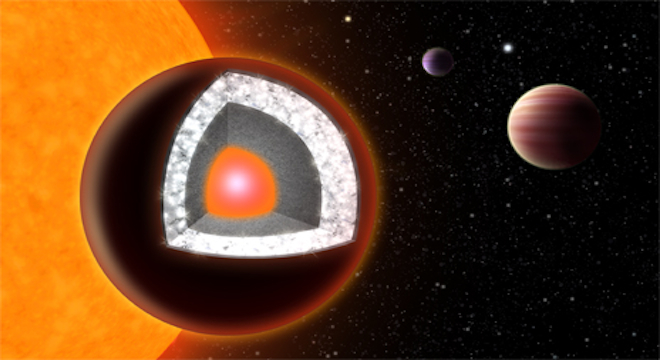The Beatles were on to something: There are, in fact, diamonds in the sky. Planets full of them.
That’s at least the new conclusion reached by researchers at Yale University and National Center for Scientific Research in France (CNRS), who have published evidence that a planet 40 light years away from Earth has at least a third of its mass made up of solid diamond.
The planet, 55 Cancri e, is considered a “super Earth,” because it is much larger than our home planet — eight times Earth’s mass and twice Earth’s radius, or about the size of Neptune.
If it is made up primarily of carbon, as researchers suspect, it could have an Earth-sized layer of diamond — a first in the known universe.
“The diamonds you would find on the surface and in the crust of this planet would be just like you would find on Earth, except very pure,” said Nikku Madhusudha, an astrophysicist at Yale who led the new study of the planet 55 Cancri e, in a phone interview with TPM. “As you went in deeper toward the core, you might find other types of diamonds, potentially even in liquid form.”
Madhusudha and his colleagues, Yale geophysicist Kanani Lee and CNRS planetary scientist Olivier Mousis, published their stunning results online in the upcoming issue of the Astrophysical Journal.
After using new measurements of the planet’s mass and radius and running through various computations of the likely interior composition, Madhusudha and his colleagues determined that the planet falls in a nebulous area when it comes to categorizing its size, somewhere between gas giants like Neptune and solid, silicate-based planets like Earth.
The planet’s star, too, contains traces of carbon, which support the idea that the planet itself — the entire system, for that matter — were formed out of a disk of carbon.
As they write in their paper:
“We show that the sum-total of available data, including the planetary mass and radius, and the stellar abundances, support the possibility of a carbon-rich interior in 55 Cancri e.”
And due to the planet’s pressure, that carbon-rich interior is most likely to be diamond, surrounded by a relatively thin layer of graphite on the surface (making up five percent of the planet).
“Diamond is the most stable form of carbon,” Madhusudha explained to TPM. “If you have carbon at high pressures, ask any geologist, what you get is diamonds.”
The researchers aren’t sure yet whether the layer is solid diamond or broken up into pieces large or small.
“What we currently think is that its a continuous layer of diamond with small chunks,” Madhusudha said. “I can’t say anything about the size of the pieces.”
Unfortunately for any prospective human prospectors who want to visit the planet from Earth, that’s not likely ever going to be a possibility, due in part to the planet’s close proximity to its host star: With a year that consists of just 18 Earth days, 55 Cancri e is profoundly hot: about 3,900 degrees Fahrenheit on its surface.
“It’d be like landing on a hot coal or kindling in a fire,” Madhusudha told TPM. “The surface of the planet would be reddish-black and glowing as if you had just put it in a bonfire.”
But there is one small consolation prize: The planet’s host star, 55 Cancri, is itself visible to the naked eye from all the way back here on Earth, located in the constellation Cancer.
Here’s a rough guide on where to look from the Northern Hemisphere come March, when Cancer will be visible again, provided by the website SkyMap Online. This view depicts the night sky over Seattle. The view has been annotated by TPM to indicate where the host star is located.

Though the planet was first discovered by other astronomers in 2008, derived from observations of radial velocity variations of light from the host star captured by the Hobby-Eberly Telescope in Texas, it wasn’t until 2011 that still other astronomers were able to discern transits across the host star and accurate measurements of its mass and radius, which allowed Madhusudhan and his colleagues to conduct their analysis.
However, as the researchers note in their paper, it will take further studies of the planet’s atmosphere to “confirm” that the composition includes a layer of diamond as suspected. Madhusudha told TPM he had already received offers and requests from other scientists at ground-based telescopes capable of spectroscopy — analyzing the wavelengths of light from a celestial object — to point their instruments at the planet and find out if its atmosphere also contains traces of carbon, further supporting the new findings.
Madhusudha said that he hoped the work he and his colleagues did in determining the diamond composition of the planet provokes a sense of discovery and appreciation for the diversity of the universe in every star-gazer.
“We’re all explorers,” Madhusudha said. “Just like the earthly explorers who were trying to find continents: You set sail hoping to find something, but you’re not sure what that may be. We’re all repeating that on a much larger scale now. That’s what we as a species should be proud of.”






